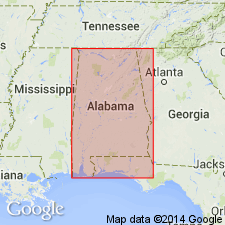
- Usage in publication:
-
- Waverly Gneiss
- Modifications:
-
- Not used
- AAPG geologic province:
-
- Piedmont-Blue Ridge province
Summary:
Waverly is not separately mapped in study area. Unit is included within the Ropes Creek Amphibolite as these felsic and mafic units are intercalated on an outcrop scale.
Source: GNU records (USGS DDS-6; Reston GNULEX).

- Usage in publication:
-
- Waverly Gneiss
- Modifications:
-
- Overview
- Dominant lithology:
-
- Gneiss
- AAPG geologic province:
-
- Piedmont-Blue Ridge province
Summary:
Type locality supplied in this report from Bentley and others (1971 Open File). Unit is described as feldspathic biotite-hornblende gneiss containing thin interlayered amphibolite, calc-silicate rock, garnet quartzite and muscovite schist. Locally rich in manganese. Deeply weathered and poorly exposed. Generalized age is Precambrian and Paleozoic.
Source: GNU records (USGS DDS-6; Reston GNULEX).

- Usage in publication:
-
- Waverly Gneiss
- Modifications:
-
- Overview
- Dominant lithology:
-
- Gneiss
- AAPG geologic province:
-
- Piedmont-Blue Ridge province
Summary:
Authors state that distribution of Waverly Gneiss versus Ropes Creek Amphibolite becomes arbitrary in northwest part of mapped area. Units are distinguished on basis of light-colored saprolite within Waverly. These units are referred to on the 1988 State map as "biotite-hornblende feldspathic gneiss and interlayered amphibolite."
Source: GNU records (USGS DDS-6; Reston GNULEX).

- Usage in publication:
-
- Waverly Gneiss*
- Modifications:
-
- Overview
- Age modified
- AAPG geologic province:
-
- Piedmont-Blue Ridge province
Summary:
Inner Piedmont is divided into two groups of rocks, Dadeville and Opelika Complexes (Bentley and Neathery, 1970), divided by Stonewall line. Dadeville Complex consists of Agricola Schist, Waresville Schist, Camp Hill Gneiss, Chattasofka Creek Gneiss, Ropes Creek Amphibolite, Waverly Gneiss, Simmons Crossroads metagranite (informal), and various unnamed mafic and ultramafic intrusive rocks. Opelika Complex consists of Loachapoka Schist, Saugahatchee quartzite, and Auburn Gneiss and schist. Farmville Metagranite intrudes these units. Age of all Inner Piedmont rocks is early Paleozoic. Report includes geologic sketch map.
[Remark reflects usage as published, not as reviewed in draft form. Although GNU review requested informal terms to be inverted, the published version shows that authors did not comply with request. Whatley Mill is misspelled as Whatley Mills in published version; error introduced after GNU review. (GNU records, USGS DDS-6; Reston GNULEX 01/21/94)]
Source: GNU records (USGS DDS-6; Reston GNULEX).
For more information, please contact Nancy Stamm, Geologic Names Committee Secretary.
Asterisk (*) indicates published by U.S. Geological Survey authors.
"No current usage" (†) implies that a name has been abandoned or has fallen into disuse. Former usage and, if known, replacement name given in parentheses ( ).
Slash (/) indicates name conflicts with nomenclatural guidelines (CSN, 1933; ACSN, 1961, 1970; NACSN, 1983, 2005, 2021). May be explained within brackets ([ ]).

